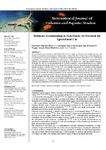Sediment Accumulation in Fish Ponds; Its Potential for Agricultural Use

View/
Date
2014Author
Muendo, Patricia N
Verdegem, Marc C J
Stoorvogel, Jetse J
Milstein, Ana
Gamal, El- Naggar
Duc, Pham Minh
Verreth, J. A. J.
Metadata
Show full item recordAbstract
ABSTRACT An experiment was conducted at the World Fish Center in Egypt, to describe and quantify sediment and nutrient accumulation in semi-intensive tilapia ponds, evaluate the effect of input type and stocking density on sediment and nutrient accumulation and estimate accumulated sediment’s potential for use in land-based agriculture. Sixteen 200 m2 earthen (but with concrete walls) ponds were allocated 4 treatments with 4 replicates in a completely randomized 2x2 factorial design. The factors were input type (chicken manure at 50 kg dm / ha / day vs 25% protein pellets fed at 3% body weight day-1) and stocking density (1 or 2 fishes / m2). All ponds were stocked with 20–25 g tilapia (Oreochromis niloticus) fingerlings and harvested after 4.5 months of culture. Ceramic tiles of 0.5 by 1 m2 were installed horizontally at 5 cm depth in the sediment before pond filling and core sediment samples were taken above the ceramic tiles at monthly intervals for determination of sediment and nutrient accumulation. The quantified sediment and nutrient accumulation were used to estimate the fertilizer potential of pond sediment in land based agriculture. Up to173 tons of sediment / ha / cycle accumulated in the semi-intensive tilapia production ponds and contained nutrients that could potentially meet the nitrogen fertilizer requirement for 0.35–1.2 hectare and the potassium fertilizer requirement for 0.7 – 1.5 hectare at recommended Egyptian fertilization rates. In addition, the accumulated sediment contained 1.8 – 5 tons of organic matter, hence, has a high potential as a soil conditioner. Sediment and nutrient accumulation were not affected by input type or stocking density.
